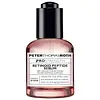What's inside
What's inside
 Key Ingredients
Key Ingredients

 Benefits
Benefits

 Concerns
Concerns

 Ingredients Side-by-side
Ingredients Side-by-side

C9-12 Alkane
SolventDimethicone
EmollientIsononyl Isononanoate
EmollientDimethyl Isosorbide
SolventTrisiloxane
Skin ConditioningCyclopentasiloxane
EmollientPolysilicone-11
Coco-Caprylate/Caprate
EmollientCaprylic/Capric Triglyceride
MaskingHydroxypinacolone Retinoate
Skin ConditioningPalmitoyl Hexapeptide-14
Skin ConditioningCeramide NP
Skin ConditioningHelianthus Annuus Seed Extract
Skin ConditioningHordeum Vulgare Extract
EmollientCucumis Sativus Extract
Skin ConditioningLaminaria Ochroleuca Extract
Skin ConditioningZingiber Officinale Root Extract
MaskingPhytosteryl Canola Glycerides
Skin ConditioningSodium Hyaluronate
HumectantSodium PCA
HumectantSqualane
EmollientTocopherol
AntioxidantLecithin
EmollientLinoleic Acid
CleansingOleic Acid
EmollientPalmitic Acid
EmollientStearic Acid
CleansingHydroxystearic Acid
CleansingTriolein
Skin ConditioningBisabolol
MaskingEthylhexyl Hydroxystearate
EmollientEthoxydiglycol
HumectantEthylhexylglycerin
Skin ConditioningWater
Skin ConditioningMica
Cosmetic ColorantPhenoxyethanol
PreservativeC9-12 Alkane, Dimethicone, Isononyl Isononanoate, Dimethyl Isosorbide, Trisiloxane, Cyclopentasiloxane, Polysilicone-11, Coco-Caprylate/Caprate, Caprylic/Capric Triglyceride, Hydroxypinacolone Retinoate, Palmitoyl Hexapeptide-14, Ceramide NP, Helianthus Annuus Seed Extract, Hordeum Vulgare Extract, Cucumis Sativus Extract, Laminaria Ochroleuca Extract, Zingiber Officinale Root Extract, Phytosteryl Canola Glycerides, Sodium Hyaluronate, Sodium PCA, Squalane, Tocopherol, Lecithin, Linoleic Acid, Oleic Acid, Palmitic Acid, Stearic Acid, Hydroxystearic Acid, Triolein, Bisabolol, Ethylhexyl Hydroxystearate, Ethoxydiglycol, Ethylhexylglycerin, Water, Mica, Phenoxyethanol
Water
Skin ConditioningGlycerin
HumectantRosa Centifolia Flower Water
Skin ConditioningPropanediol
SolventAlcohol Denat.
AntimicrobialSqualene
EmollientTetrapeptide-17
Skin ConditioningPalmitoyl Dipeptide-10
Skin ConditioningPalmitoyl Tetrapeptide-7
Skin ConditioningPalmitoyl Hexapeptide-19
Skin ConditioningPalmitoyl Oligopeptide
CleansingTripeptide-10 Citrulline
Skin ConditioningTripeptide-1
Skin ConditioningCaprooyl Tetrapeptide-3
Skin ProtectingAcetyl Octapeptide-3
HumectantAcetyl Hexapeptide-30
Skin ConditioningAcetyl Hexapeptide-8
HumectantPentapeptide-18
Skin ConditioningPalmitoyl Tripeptide-5
Skin ConditioningPalmitoyl Tripeptide-38
Skin ConditioningDipeptide Diaminobutyroyl Benzylamide Diacetate
Skin ConditioningAcetyl Hexapeptide-20
Skin ConditioningSodium Hyaluronate
HumectantArginine
MaskingTocopheryl Acetate
AntioxidantRetinyl Palmitate
Skin ConditioningAscorbyl Palmitate
AntioxidantPseudoalteromonas Ferment Extract
HumectantHydrolyzed Wheat Protein
Skin ConditioningHydrolyzed Soy Protein
HumectantAcetylarginyltryptophyl Diphenylglycine
Skin ConditioningHydroxypropyl Cyclodextrin
MaskingIsopropyl Myristate
EmollientButylene Glycol
HumectantPolysorbate 20
EmulsifyingGluconolactone
Skin ConditioningXanthan Gum
EmulsifyingLecithin
EmollientCarbomer
Emulsion StabilisingDextran
Triethanolamine
BufferingPotassium Sorbate
PreservativeSodium Benzoate
MaskingCaprylyl Glycol
EmollientPropylene Glycol
HumectantDiazolidinyl Urea
PreservativeMethylparaben
PreservativePropylparaben
PreservativeIsobutylparaben
AntimicrobialEthylparaben
PreservativeButylparaben
MaskingPhenoxyethanol
PreservativeCI 17200
Cosmetic ColorantWater, Glycerin, Rosa Centifolia Flower Water, Propanediol, Alcohol Denat., Squalene, Tetrapeptide-17, Palmitoyl Dipeptide-10, Palmitoyl Tetrapeptide-7, Palmitoyl Hexapeptide-19, Palmitoyl Oligopeptide, Tripeptide-10 Citrulline, Tripeptide-1, Caprooyl Tetrapeptide-3, Acetyl Octapeptide-3, Acetyl Hexapeptide-30, Acetyl Hexapeptide-8, Pentapeptide-18, Palmitoyl Tripeptide-5, Palmitoyl Tripeptide-38, Dipeptide Diaminobutyroyl Benzylamide Diacetate, Acetyl Hexapeptide-20, Sodium Hyaluronate, Arginine, Tocopheryl Acetate, Retinyl Palmitate, Ascorbyl Palmitate, Pseudoalteromonas Ferment Extract, Hydrolyzed Wheat Protein, Hydrolyzed Soy Protein, Acetylarginyltryptophyl Diphenylglycine, Hydroxypropyl Cyclodextrin, Isopropyl Myristate, Butylene Glycol, Polysorbate 20, Gluconolactone, Xanthan Gum, Lecithin, Carbomer, Dextran, Triethanolamine, Potassium Sorbate, Sodium Benzoate, Caprylyl Glycol, Propylene Glycol, Diazolidinyl Urea, Methylparaben, Propylparaben, Isobutylparaben, Ethylparaben, Butylparaben, Phenoxyethanol, CI 17200
Ingredients Explained
These ingredients are found in both products.
Ingredients higher up in an ingredient list are typically present in a larger amount.
Lecithin is a term for a group of substances found in the cell membranes of plants, animals, and humans. They are made up of mixture of phospholipids.
This ingredient has emollient and emulsifying properties.
As an emollient, lecithen helps soften the skin and creates a barrier to keep moisture in.
As an emulsifier, it also helps prevent water and oil ingredients from separating. Lecithin can also help ingredients be better absorbed by the skin.
This is because the phospholipids in lecithin produce liposomes. Liposomes help other ingredients get through the skin barrier.
Depending on the source of this ingredient, lecithin may not be fungal acne safe. This is because some sources of lecithin come from soybean oil, which may feed the malassezia yeast that feeds fungal acne.
We recommend reaching out to the brand you are purchasing from to inquire about the source of their lecithin.
Some other names for this ingredient include soy lecithin and deoiled soy lecithin.
Learn more about LecithinPhenoxyethanol is a preservative that has germicide, antimicrobial, and aromatic properties. Studies show that phenoxyethanol can prevent microbial growth. By itself, it has a scent that is similar to that of a rose.
It's often used in formulations along with Caprylyl Glycol to preserve the shelf life of products.
Sodium Hyaluronate is hyaluronic acid's salt form. It is commonly derived from the sodium salt of hyaluronic acid.
Like hyaluronic acid, it is great at holding water and acts as a humectant. This makes it a great skin hydrating ingredient.
Sodium Hyaluronate is naturally occurring in our bodies and is mostly found in eye fluid and joints.
These are some other common types of Hyaluronic Acid:
Learn more about Sodium HyaluronateWater. It's the most common cosmetic ingredient of all. You'll usually see it at the top of ingredient lists, meaning that it makes up the largest part of the product.
So why is it so popular? Water most often acts as a solvent - this means that it helps dissolve other ingredients into the formulation.
You'll also recognize water as that liquid we all need to stay alive. If you see this, drink a glass of water. Stay hydrated!
Learn more about Water